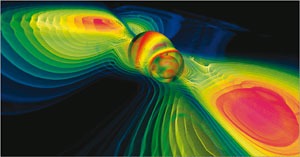The European Commission (EC) has allocated €3 million within the Seventh Framework Programme for preliminary studies for the development of the Einstein Telescope – a major new gravitational-wave observatory. The Einstein Telescope is one of the “magnificent seven” European projects recommended by the ASPERA network for the future development of astroparticle physics in Europe.

Image credit: MPI for Gravitational Physics/W Benger-ZIB.
With this grant, the commission confirms the importance of gravitational-wave research for both basic and applied scientific research in Europe. The direct detection of gravitational waves will allow new insights into the universe that are inaccessible to any other technology – including clues to its origin.
The funds granted now by the EC will be used in a design study for the Einstein Telescope over the next three years. This is an important step towards the third generation of gravitational-wave observatories. It will define the specifications for the required site and infrastructure, the necessary technologies, and the total budget.
Currently, several first-generation gravitational-wave detectors are operational worldwide. The German-British GEO600 observatory operates close to Hanover while the French-Italian-Dutch Virgo project is located in Cascina near Pisa. These interferometers pool their data with the three LIGO interferometers in the US and are currently doing extensive searches for gravitational waves from astrophysical systems.
During the next decade all interferometric gravitational-wave detectors will be upgraded to second-generation instruments. Virgo and LIGO will gain a factor of about 10 in sensitivity at lower frequencies (up to about 1 kHz). GEO will pioneer high-frequency wide-band observing above 1 kHz, again deploying new technologies. If the current instruments do not make the first detection of gravitational waves, the second-generation interferometers should succeed.
The Einstein Telescope project fits well into this scenario. After the completion of the design study and a subsequent technical preparation phase, construction could begin (probably in 2017 or 2018) after the second-generation observatories have started operating. As a third-generation observatory, Einstein should be 100 times as sensitive as current detectors, increasing the observable volume of the universe by a factor of a million. Additionally, it should cover the frequency range between 1 Hz and 10 kHz.
• The Einstein Telescope is a joint project of eight European research institutes, under the direction of the European Gravitational Observatory (EGO). The participants are EGO, an Italian-French consortium located near Pisa, INFN, the Centre National de la Recherche Scientifique, the Albert Einstein Institute in Hannover, the Universities of Birmingham, Cardiff and Glasgow and the Vrije Universiteit, Amsterdam.





